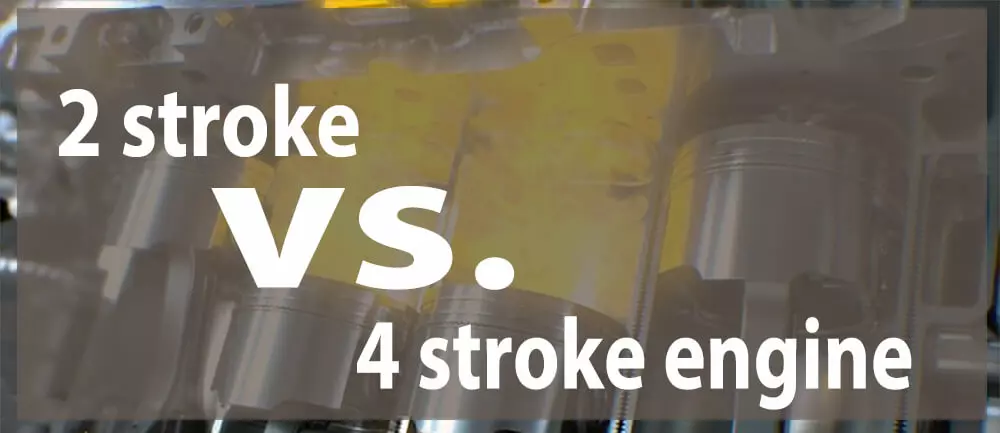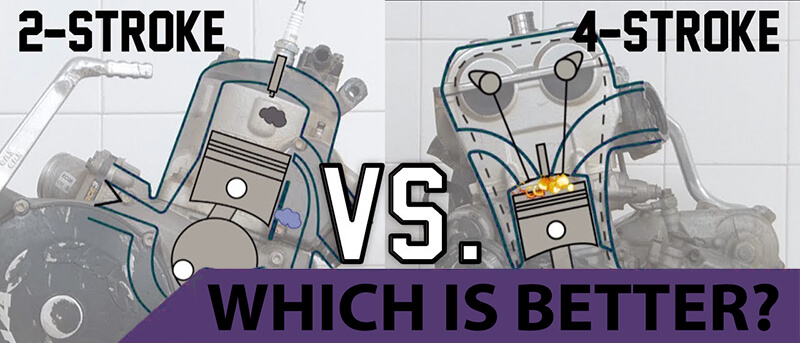25Oct 2023
table of contents

Two-stroke and four-stroke engines are distinct types of internal combustion engines that find widespread usage across various applications. Let's explore the differences, advantages, disadvantages, and applications between these two engine types to understand how they differ.
Two-stroke engines are designed to complete the power cycle using only two strokes of the piston - the upstroke and the downstroke. These strokes encompass the compression stroke and the combustion/exhaust stroke. These engines do not have separate intake and exhaust valves. Instead, they rely on ports to control the flow of air-fuel mixture and exhaust gases. Two-stroke engines are known for their simple, lightweight design.
Four-stroke engine: This type of engine goes through four distinct stages to complete a power cycle. These stages consist of the intake stroke, compression stroke, combustion stroke, and exhaust stroke. It utilizes a camshaft to control separate intake and exhaust valves. Four-stroke engines are known for their efficiency and durability.
Simplicity: Two-stroke engines have a streamlined design with fewer parts, making them easier to maintain and repair. With fewer components, mechanical failure is less likely, simplifying maintenance procedures.
Less-weight: Two-stroke engines are an excellent choice for weight-sensitive applications like handheld devices and small vehicles due to their lighter build compared to four-stroke engines. Their lightweight nature offers a practical solution for those who prioritize weight reduction.
High power-to-weight ratio: Due to its efficient design, two stroke engines pack more power in a smaller space than their four stroke counterparts. This makes them ideal for applications requiring high performance in a compact package.
Uniform rotational motion of the engine: In a two-stroke engine, a power stroke occurs with each revolution of the crankshaft, providing a more consistent and continuous rotational motion.
Can operate in cold and hot outdoor temperatures: The combustion process in two-stroke engines is generally faster and more efficient, allowing the engine to start and run reliably even in cooler conditions. Additionally, the simple design of a two-stroke engine contributes to its ability to operate efficiently in hotter environments because there are fewer complex components affected by heat.
Higher fuel consumption: Two stroke engines consume more fuel than four stroke engines due to the way fuel and oil mix during combustion. Fortunately, the fuel efficiency of modern two stroke engines has been enhanced through advancements in fuel injection technology.
Higher emissions: Two stroke engines emit higher levels of air pollutants and unburned hydrocarbons, which can harm the environment and air quality. However, stricter emissions regulations and the advancement of cleaner-burning fuels are gradually mitigating this issue.
Shortened lifespan: Two stroke engines, with their less complex design compared to four stroke engines, experience greater wear and a shorter overall lifespan. To increase the longevity of your engine, regular maintenance and proper lubrication are crucial.
More noisy: You may experience strong vibration or noise during operation.
Low power range: Two-stroke engines have a narrow power band, or range of speeds at which the engine is most efficient.
Two-stroke power cleaning is more troublesome: You may have problems cleaning this engine.
Small handheld devices: Two stroke engines are commonly used in chain saws, leaf blowers, trimmers, and other portable tools.
Motorcycles and scooters: Many motorcycles and scooters use two stroke engines due to their lightweight and compact design.
Marine Engines: Two stroke engines are used in small boats and personal watercraft.

Due to its design and combustion cycle, four stroke engines produce higher torque at lower rpm during operation.
Better fuel efficiency: Four stroke engines excel in fuel more efficient when compared to two stroke engines.
Less fuel consumption: Fuel is consumed only once every four strokes, and separate intake and exhaust strokes allow for better control of the combustion process, resulting in less fuel consumption and lower operating costs.
Lower emissions: Four-stroke engines produce fewer emissions due to separate intake and exhaust valves. They comply with stricter environmental regulations and help improve air quality. BISON low-power has also passed Euro 5 emission certification and reached low emission standards.
Longer life: The four-stroke engine's rugged design and slower operating speed increase its durability and longevity. Proper maintenance ensures these engines deliver dependable performance over an extended period.
Less noise: Four-stroke engines are designed and operate to reduce noise and vibration compared to two-stroke engines.
Complex design: Four stroke engines have a more complex design with a higher number of moving parts. Increasing efficiency comes at a cost - an increased risk of mechanical failure. To achieve optimal performance, regular maintenance and expertise are crucial. Therefore, the costs associated with repairs and maintenance are also increasing.
Heavier weight: Four stroke engines are typically heavier compared to two stroke engines. Weight can greatly impact applications like handheld devices and light vehicles etc, making them crucial to minimize weight.
Lower power-to-weight ratio: Four stroke engines may offer lower power compared to two stroke engines of the same size. This can be disadvantage for applications needing compact yet high-power solutions.
Automobile industry: Four-stroke engines are widely used in cars, trucks and other road vehicles.
Generators: Many portable and stationary generators rely on four-stroke engines for reliable operation. These engines provide stable power, making them suitable for backup power solutions and various industrial applications.
Heavy machinery: Construction equipment, agricultural machinery, and industrial machinery often utilize four-stroke engines to provide power and torque capabilities.

Determining which engine is better depends on the specific application and requirements. When it comes to engines, the two stroke and four stroke each have their own strengths. Two stroke engines is ideal for prioritize simplicity, lightweight design, and a high power-to-weight ratio. Four stroke engines excel in fuel efficiency, long-term durability and emissions control. Gain a understanding of the distinctive characteristics of different small engine types, to make an informed choice that suits your specific requirements.
To explore further and find the perfect engine for your requirements, contact our experts or visit our website for more information. BISON small engines is the trusted choice when it comes to selecting quality parts and equipment for your small engine needs. With a wide range of high-quality products and a reputation for excellent customer service, BISON ensures you get reliable parts and equipment to keep your engine running smoothly.
inquiry form here
BISON BLOG, All the latest news and views from Bison Machinery.